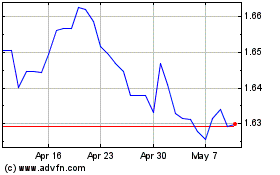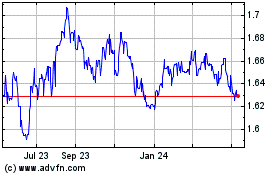Euro Lower As ECB Stimulus Hopes Rise After Soft Eurozone Data
July 31 2019 - 2:49AM
RTTF2
The euro came under pressure against its major counterparts in
the European session on Wednesday, as a slowdown in Euro zone
economic growth in the second quarter and inflation in July
intensified hopes that the European Central Bank will announce
stimulus measures in September.
Flash estimate from Eurostat showed that the euro area economy
expanded at a slower pace as expected in the second quarter.
Gross domestic product grew 0.2 percent sequentially, following
the first quarter's 0.4 percent expansion. The rate came in line
with expectations.
On a yearly basis, economic growth eased to 1.1 percent from 1.2
percent. Nonetheless, the rate of growth exceeded the expected 1
percent.
Separate data showed that Eurozone consumer price inflation
slowed in July, after rising in the previous month.
Headline inflation eased to 1.1 percent from 1.3 percent in
June. The slowing was in line with economists' expectations.
Core inflation, which strips out the volatile energy, food,
alcohol & tobacco prices, slowed to 0.9 percent from 1.1
percent. Economists had forecast 1 percent.
Another report showed that the unemployment rate reached its
lowest level in almost 11 years in June.
The jobless rate dropped to 7.5 percent in June, as expected,
from 7.6 percent in May. This was the lowest since July 2008.
Unemployment decreased by 45,000 from May to 12.377 million in
June.
European stocks were mixed as investors digested mixed earnings
and looked ahead to the latest monetary policy decision from the
Federal Reserve for clues on the policy path. It will be up to
Chair Powell to steer market expectations for more rate cuts via
the press conference.
The currency was trading mixed against its major counterparts in
the Asian session. While it held steady against the greenback and
the pound, it fell against the yen. Against the franc, it
advanced.
The euro was trading at 1.1144 against the greenback, down from
a 6-day high of 1.1162 hit at 2:15 am ET. The pair had closed
Tuesday's deals at 1.1155. The currency is likely to find support
around the 1.09 level.
The European currency ticked down to 120.98 against the yen from
yesterday's closing value of 121.12. The euro is seen finding
support around the 118.00 level.
Data from the Cabinet Office showed that Japan's consumer
confidence weakened to the lowest level in five-and-a-half years in
June.
The consumer confidence index for households with two or more
persons fell to a seasonally adjusted 37.8 in July from 38.7 in
June. Economists had expected a score of 38.5.
After a 5-day rise to 1.1062 against the Swiss franc at 1:30 am
ET, the euro pulled back to 1.1040. On the downside, 1.07 is
possibly seen as the next support level for the euro.
The euro edged down to 0.9157 against the pound, following an
advance to 0.9181 at 5:30 pm ET. If the euro declines further, it
may find support around the 0.885 level.
Data from the Nationwide Building Society showed that UK house
prices increased for the second straight month in July.
House prices grew 0.3 percent month-on-month, faster than the
0.1 percent rise in June and the expected 0.2 percent increase.
The euro fell to 1.6852 against the kiwi and 1.6161 against the
aussie, from its early near a 3-week high of 1.6930 and more than a
4-week high of 1.6248, respectively. The next possible support
levels for the euro are seen around 1.66 against the kiwi and 1.59
against the aussie.
On the flip side, the euro held steady against the loonie, after
having declined to a 2-day low of 1.4648 at 9:15 pm ET. At
yesterday's close, the pair was worth 1.4669.
Looking ahead, U.S. ADP private payrolls data for July will be
published at 8:15 am ET.
In the New York session, Canada GDP data for May and industrial
product price index for June will be out.
At 2:00 pm ET, the Federal Reserve's interest rate decision is
slated for release. Economists widely expect the central bank to
cut rates to 2.00 percent - 2.25 percent.
Euro vs AUD (FX:EURAUD)
Forex Chart
From Mar 2024 to Apr 2024

Euro vs AUD (FX:EURAUD)
Forex Chart
From Apr 2023 to Apr 2024
